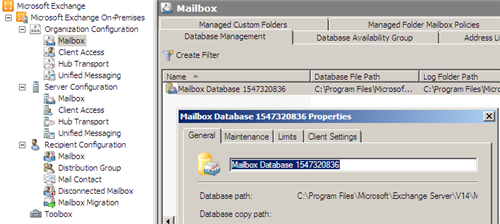As with earlier versions of Exchange Server when you first install Exchange Server 2010 it configures the first mailbox database for you. In Exchange Server 2007 this database was placed in a Storage Group called “First Storage Group” and was simply named “Mailbox Database”.
This was not a problem in earlier versions of Exchange. Databases were always named relative to the server they were hosted on and the storage group they were contained within, so a database named “Mailbox Database” on SERVER01 had a unique name such as “SERVER01First Storage GroupMailbox Database” which would not conflict with another database named “SERVER01Second Storage GroupMailbox Database”, even though they are both named “Mailbox Database”.
When you look at the first mailbox database on your Exchange Server 2010 server you’ll notice the naming is different. Here is an example.
The first database name has a random number appended to it that is designed to be unique to that Exchange organisation. That seems strange until you consider it in the context of the new Exchange Server 2010 database concepts. Here it is explained by Paul Robichaux:
Here’s the deal: in Exchange 2007 and earlier, mailbox and public folder databases are children of server objects. That means that you can uniquely identify a database by a combination of its name (which may not be unique throughout the forest) and its server name (which is guaranteed by AD to be unique). In Exchange 2010, the database is no longer “owned” by a particular server. Instead, it’s a member of a DAG, and it may actually become active on any server in the DAG at any time. That means that your database names shouldn’t include the name of the server. DAGs can span AD sites, too, so guess what: don’t use the AD site name (or the name of the physical datacenter) either. Otherwise the name of the database may not correspond in any way to where the database is actually active.
To learn more about Database Availability Groups check out this Technet article.




Pingback: Exchange Server 2010 Reaches RTM Milestone | Exchange Server Pro
Hi
I just wanted to know that what is the default size of Mailbox Database in Exchange 2010.
Regards,
Subhash tiwari